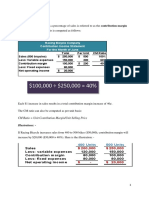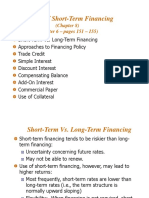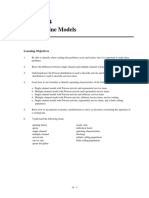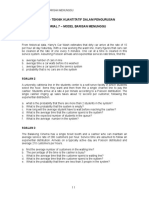CVPAnalysisVideoSlides 001
CVPAnalysisVideoSlides 001
Uploaded by
Iqra JawedCopyright:
Available Formats
CVPAnalysisVideoSlides 001
CVPAnalysisVideoSlides 001
Uploaded by
Iqra JawedOriginal Description:
Original Title
Copyright
Available Formats
Share this document
Did you find this document useful?
Is this content inappropriate?
Copyright:
Available Formats
CVPAnalysisVideoSlides 001
CVPAnalysisVideoSlides 001
Uploaded by
Iqra JawedCopyright:
Available Formats
CVP Analysis
1
Uses of the Contribution Format Uses o t e Co t but o o at
Th t ib ti i t t t f t i d Th t ib ti i t t t f t i d The contribution income statement format is used The contribution income statement format is used
as an internal planning and decision making tool. as an internal planning and decision making tool.
Thi h i f l f Thi h i f l f This approach is useful for: This approach is useful for:
1. 1. Cost Cost--volume volume--profit analysis profit analysis p y p y
2. 2. Budgeting Budgeting
3. 3. Segmented reporting of profit Segmented reporting of profit data data
44 Special decisions s ch as pricing and make Special decisions s ch as pricing and make or or 4. 4. Special decisions such as pricing and make Special decisions such as pricing and make--or or--
buy buy analysis analysis
2
The Contribution Format
Used primarily for Used primarily for
external reporting external reporting
Used primarily by Used primarily by
management management external reporting. external reporting. management. management.
3
The Contribution Format
Total Uni t Total Uni t
Sal es Revenue 100,000 $ 50 $
Less: Vari abl e costs 60 000 30 Less: Vari abl e costs 60,000 30
Contri buti on margi n 40,000 $ 20 $
Less: Fi xed costs 30,000
Net operati ng i ncome 10,000 $
Th t ib ti i f t h i Th t ib ti i f t h i The contribution margin format emphasizes The contribution margin format emphasizes
cost behavior. Contribution margin covers fixed cost behavior. Contribution margin covers fixed
t d id f i t d id f i costs and provides for income. costs and provides for income.
4
3-2
5
CVP Relationships in Graphic Form
The relationship among revenue, cost, profit and
l b d hi ll b i volume can be expressed graphically by preparing
a CVP graph. Racing developed contribution
margin income statements at 300, 400, and 500 margin income statements at 300, 400, and 500
units sold. We will use this information to prepare
the CVP graph.
Income
300 uni ts
Income
400 uni ts
Income
500 uni ts
$ $ $ Sal es 150,000 $ 200,000 $ 250,000 $
Less: vari abl e expenses 90,000 120,000 150,000
Contri buti on margi n 60,000 $ 80,000 $ 100,000 $ g
Less: fi xed expenses 80,000 80,000 80,000
Net operati ng i ncome (20,000) $ - $ 20,000 $
6
CVP Graph
4 0 000
350 000
400,000
450,000
Total Sales
250,000
300,000
350,000
Total Expenses
Total Sales
150,000
200,000
,
Fixed Expenses
Total Expenses
50,000
100,000
-
- 100 200 300 400 500 600 700 800
U it Units
7
CVP Graph
4 0 000
350 000
400,000
450,000
Break Break--even point even point
(400 units or $200,000 in sales) (400 units or $200,000 in sales)
250,000
300,000
350,000
150,000
200,000
,
50,000
100,000
-
- 100 200 300 400 500 600 700 800
U it Units
8
Contribution Margin Ratio
The contribution margin ratio is:
Total CM
CM R ti
For Racing Bicycle Company the ratio is:
Total CM
Total sales
CM Ratio =
For Racing Bicycle Company the ratio is:
= 40%
$80,000
Each $1 00 increase in sales results in a
= 40%
$200,000
Each $1.00 increase in sales results in a
total contribution margin increase of 40.
9
Contribution Margin Ratio
O i t f it th t ib ti i ti i Or, in terms of units, the contribution margin ratio is:
Unit CM
CM Ratio =
For Racing Bicycle Company the ratio is:
Unit selling price
CM Ratio =
For Racing Bicycle Company the ratio is:
$200 $200
$500
= 40%
10
Contribution Margin Ratio
400 Bi kes 500 Bi kes
Sal es 200,000 $ 250,000 $
Less: vari abl e expenses 120,000 150,000
Contri buti on margi n 80,000 100,000
L fi d 80 000 80 000 Less: fi xed expenses 80,000 80,000
Net operati ng i ncome - $ 20,000 $
A $50,000 increase in sales revenue A $50,000 increase in sales revenue
results in a $20 000 increase in CM results in a $20 000 increase in CM results in a $20,000 increase in CM. results in a $20,000 increase in CM.
($50,000 ($50,000 40% = $20,000) 40% = $20,000)
11
Break-Even Analysis
Here is the information from Racing Bicycle Company:
Total Per Uni t Percent
Sal es (500 bi kes) 250,000 $ 500 $ 100%
Less: vari abl e expenses 150 000 300 60% Less: vari abl e expenses 150,000 300 60%
Contri buti on margi n 100,000 $ 200 $ 40%
Less: fi xed expenses 80,000
Net operati ng i ncome 20,000 $
12
Contribution Margin Method
The contribution margin method has two The contribution margin method has two
key equations.
Fi d B k i Fixed expenses
CM per unit
=
Break-even point
in units sold
Fixed expenses
CM ratio
=
Break-even point in
total sales dollars
CM ratio
13
Contribution Margin Method
Lets use the contribution margin method Lets use the contribution margin method
to calculate the break-even point in total
sales dollars at Racing.
Fi d
Break even point in
Fixed expenses
CM ratio
=
Break-even point in
total sales dollars
$80,000 $80,000
40% 40%
= $200,000 break = $200,000 break--even sales even sales
40% 40%
$ 00,000 b ea $ 00,000 b ea e e saes e e saes
14
Target Profit Analysis
Suppose Racing Bicycle Company wants Suppose Racing Bicycle Company wants
to know how many bikes must be sold y
to earn a profit of $100,000.
15
The Contribution Margin Approach
The contribution margin method can be The contribution margin method can be
used to determine that 900 bikes must be
f f $100 000 sold to earn the target profit of $100,000.
Fi d + T t fit U it l t tt i Fixed expenses + Target profit
CM per unit
=
Unit sales to attain
the target profit
$80,000 + $100,000
$200/bik
= 900 bikes
$200/bike
900 bikes
16
The Margin of Safety
Th i f f t i th f The margin of safety is the excess of
budgeted (or actual) sales over the
break-even volume of sales.
M i f f t T t l l B k l Margin of safety = Total sales - Break-even sales
Lets look at Racing Bicycle Company and
determine the margin of safety. g y
17
The Margin of Safety
If we assume that Racing Bicycle Company has actual g y p y
sales of $250,000, given that we have already
determined the break-even sales to be $200,000, , ,
the margin of safety is $50,000 as shown.
Break-even
sal es
400 uni ts
Actual sal es
500 uni ts 400 uni ts 500 uni ts
Sal es 200,000 $ 250,000 $
Less: vari abl e expenses 120,000 150,000
Contri buti on margi n 80 000 100 000 Contri buti on margi n 80,000 100,000
Less: fi xed expenses 80,000 80,000
Net operati ng i ncome - $ 20,000 $
18
The Margin of Safety
The margin of safety can be expressedas The margin of safety can be expressed as
20% of sales.
($50 000$250 000) ($50,000 $250,000)
Break-even
sal es
400 uni ts
Actual sal es
500 uni ts 400 uni ts 500 uni ts
Sal es 200,000 $ 250,000 $
Less: vari abl e expenses 120,000 150,000
Contri buti on margi n 80 000 100 000 Contri buti on margi n 80,000 100,000
Less: fi xed expenses 80,000 80,000
Net operati ng i ncome - $ 20,000 $
19
The Margin of Safety
The margin of safety can be expressedin The margin of safety can be expressed in
terms of the number of units sold. The
margin of safety at Racing is $50 000 and margin of safety at Racing is $50,000, and
each bike sells for $500.
Margin of
100 bik
$50,000 Margin of
Safety in units
= = 100 bikes
$50,000
$500
20
Operating Leverage
A measure of howsensitive net operating A measure of how sensitive net operating
income is to percentage changes in sales.
Contribution margin Degree of Contribution margin
Net operating income
Degree of
operating leverage
=
21
Operating Leverage
At Racing the degree of operating leverage is 5
Actual sales
At Racing, the degree of operating leverage is 5.
500 Bikes
Sales 250,000 $
Less: variable expenses 150,000
Contribution margin 100,000
Less: fixed expenses 80,000
Net income 20,000 $
$100,000
= 5
,
$20,000
= 5
22
Operating Leverage
With an operating leverage of 5 if Racing With an operating leverage of 5 if Racing With an operating leverage of 5, if Racing With an operating leverage of 5, if Racing
increases its sales by 10%, net operating increases its sales by 10%, net operating
income o ld increase b 50% income o ld increase b 50% income would increase by 50%. income would increase by 50%.
P t i i l
10%
Percent increase in sales
10%
Degree of operating leverage
5
Percent increase in profits
50%
Heres the verification!
23
Operating Leverage
Actual sal es Increased Actual sal es
(500)
Increased
sal es (550)
Sal es 250,000 $ 275,000 $
Less vari abl e expenses 150,000 165,000
Contri buti on margi n 100,000 110,000
Less fi xed expenses 80,000 80,000
Net operati ng i ncome 20,000 $ 30,000 $
10% increase in sales from
$250,000 to $275,000 . . .
. . . results in a 50%increase in . . . results in a 50% increase in
income from $20,000 to $30,000.
24
The Concept of Sales Mix
S l i i th l ti ti i hi h Sales mix is the relative proportion in which a
companys products are sold.
Different products have different selling prices,
cost structures, and contribution margins.
Lets assume Racing Bicycle Company sells g y p y
bikes and carts and that the sales mix between
the two products remains the same. p
25
Multi-product break-even analysis
Racing Bicycle Co. provides the following information:
$265 000 $265,000
$550,000
= 48.2% (rounded)
26
Multi-product break-even analysis
Fixed expenses
CM Ratio
Break-even
sales
$170 000
=
$170,000
48.2%
= $352 697
=
= $352,697
27
Key Assumptions of CVP Analysis
Selling price is constant. Selling price is constant.
Costs are linear.
In multiproduct companies, the sales mix is
constant. constant.
In manufacturing companies, inventories do
t h ( it d d it ld) not change (units produced = units sold).
28
You might also like
- CVP ANALYSISfDocument56 pagesCVP ANALYSISfManzzieNo ratings yet
- Sol Q3Document4 pagesSol Q3hanaNo ratings yet
- 107 W5 6 CVP chp04 STDocument101 pages107 W5 6 CVP chp04 STmargaret mariaNo ratings yet
- Topic 11 (CVP)Document41 pagesTopic 11 (CVP)PrabhuNo ratings yet
- Cost-Volume-Profit RelationshipsDocument82 pagesCost-Volume-Profit Relationshipsquangdu0405No ratings yet
- Chapter 6 CVP AnalysisDocument27 pagesChapter 6 CVP AnalysisMariel Angeli Chan100% (1)
- CVP 2203workshopDocument40 pagesCVP 2203workshopAyan ShahNo ratings yet
- Chap005 CVP RelationshipDocument18 pagesChap005 CVP Relationshipsetia.brightyNo ratings yet
- Chap5 (E)Document60 pagesChap5 (E)Kiên Lê TrungNo ratings yet
- Cost-Volume-Profit Relationships: Principles of Management AccountingDocument16 pagesCost-Volume-Profit Relationships: Principles of Management Accountingsyed haider ali shah shah100% (1)
- Chap 005Document110 pagesChap 005Steven LohNo ratings yet
- Cost-Volume-Profit RelationshipsDocument81 pagesCost-Volume-Profit RelationshipsAbdirahim HusseinNo ratings yet
- Chap005 StudentsDocument18 pagesChap005 StudentsOussama FathallahNo ratings yet
- Cost-Volume-Profit Relationships: Chapter SixDocument82 pagesCost-Volume-Profit Relationships: Chapter Sixstudnt07No ratings yet
- Chapter3 CVP RelationshipDocument20 pagesChapter3 CVP RelationshipCarina Carollo MalinaoNo ratings yet
- Cost-Volume-Profit RelationshipsDocument15 pagesCost-Volume-Profit Relationships027 - Dyan Febita SariNo ratings yet
- Cost Volume & ProfitDocument40 pagesCost Volume & ProfitNitin Sharma100% (2)
- Chapter 6 Garrison 13eDocument82 pagesChapter 6 Garrison 13efarhan MomenNo ratings yet
- Session 10-11, CVP Analysis - PPTX (Repaired)Document35 pagesSession 10-11, CVP Analysis - PPTX (Repaired)Nikhil ChitaliaNo ratings yet
- Chapter 5Document21 pagesChapter 5Kazi Khalid HossainNo ratings yet
- Chapter 5 CVPDocument71 pagesChapter 5 CVPmujahidrezarafat5No ratings yet
- Lecture-6-CVP-A-Reading Materials PDFDocument71 pagesLecture-6-CVP-A-Reading Materials PDFFerdausNo ratings yet
- Chapter 6 CVPDocument81 pagesChapter 6 CVPPrometheus SmithNo ratings yet
- Department of Accounting & Information Systems Dhaka UniversityDocument34 pagesDepartment of Accounting & Information Systems Dhaka UniversityMd. Mamunur RashidNo ratings yet
- Session 3 CVPDocument102 pagesSession 3 CVP11A8.01. Hoàng Phú AnNo ratings yet
- Notes - Lecture 3.1.3Document2 pagesNotes - Lecture 3.1.3Sakiful IslamNo ratings yet
- Session 5Document83 pagesSession 5SiddharthNo ratings yet
- Intro To Cost AccountDocument30 pagesIntro To Cost AccountHoussein MedNo ratings yet
- CVP Analysis - Lecture NotesDocument11 pagesCVP Analysis - Lecture NotesOtenyo MeshackNo ratings yet
- Session - 7Document83 pagesSession - 7Harsh MaheshwariNo ratings yet
- CVP 2203workshop PDFDocument43 pagesCVP 2203workshop PDFsujulove foreverNo ratings yet
- IPPTChap 003Document97 pagesIPPTChap 003Rina TruNo ratings yet
- The Profit Function Breakeven Analysis Differential Cost AnalysisDocument27 pagesThe Profit Function Breakeven Analysis Differential Cost AnalysisMickel AlexanderNo ratings yet
- CH 03 CPVDocument101 pagesCH 03 CPVsurpluslemonNo ratings yet
- Notes - Lecture 3.2.1Document2 pagesNotes - Lecture 3.2.1Sakiful IslamNo ratings yet
- CVP 2203workshopDocument40 pagesCVP 2203workshopGelyn CruzNo ratings yet
- A WK6 Chp5Document97 pagesA WK6 Chp5Jocelyn LimNo ratings yet
- CVP AnalysisDocument43 pagesCVP Analysisprotik1919100% (1)
- Acct Cost Volume Profit Analysis PDFDocument5 pagesAcct Cost Volume Profit Analysis PDFSheena Glaiza BelchesNo ratings yet
- Cost-Volume-Profit RelationshipsDocument18 pagesCost-Volume-Profit Relationshipsfarhan izharuddinNo ratings yet
- Cost Volume Profit Analysis Lecture NotesDocument34 pagesCost Volume Profit Analysis Lecture NotesAra Reyna D. Mamon-DuhaylungsodNo ratings yet
- AnswerDocument7 pagesAnswerNa HàNo ratings yet
- Chapter 3 TrimmedDocument19 pagesChapter 3 Trimmedssregens82No ratings yet
- Cost Concepts: Gross Margin and Contribution MarginDocument9 pagesCost Concepts: Gross Margin and Contribution MarginMahediNo ratings yet
- W11-12 Cost-Volume-Profit RelationshipsDocument82 pagesW11-12 Cost-Volume-Profit RelationshipsQurat SaboorNo ratings yet
- Chapter 5 PDFDocument71 pagesChapter 5 PDFSyed Atiq TurabiNo ratings yet
- Management Accounting - Hansen Mowen CH16Document39 pagesManagement Accounting - Hansen Mowen CH16Gito NovhandraNo ratings yet
- 2-Contribution Margin:: - WithDocument6 pages2-Contribution Margin:: - WithAlyn AlconeraNo ratings yet
- Cost Volume Profit AnalysisDocument47 pagesCost Volume Profit Analysismalcolmmcnab139No ratings yet
- Cost-Volume-Profit Analysis: A Managerial Planning ToolDocument39 pagesCost-Volume-Profit Analysis: A Managerial Planning ToolYana MarsiamilaNo ratings yet
- Topic 04 - Cost and Management Accounting Course Notes 2021 PWC Conversion ProgrammeDocument84 pagesTopic 04 - Cost and Management Accounting Course Notes 2021 PWC Conversion ProgrammejerrymaNo ratings yet
- A181 Bkam3023 Topic 1 - CVP AnalysisDocument64 pagesA181 Bkam3023 Topic 1 - CVP AnalysisJagethiswari RajahNo ratings yet
- LChpt18 CVPadjDocument43 pagesLChpt18 CVPadjJacqueline LieNo ratings yet
- CVP Analysis - The Basics: Contribution Margin - IllustrationsDocument2 pagesCVP Analysis - The Basics: Contribution Margin - IllustrationsSakiful IslamNo ratings yet
- Chapter 5 CVP Analysis-1Document29 pagesChapter 5 CVP Analysis-1Ummay HabibaNo ratings yet
- Cost-Volume-Profit RelationshipsDocument97 pagesCost-Volume-Profit RelationshipsAyaNo ratings yet
- Exercise 6-5 (20 Minutes) : Per Unit Percent of SalesDocument11 pagesExercise 6-5 (20 Minutes) : Per Unit Percent of SalesPrasoon SriNo ratings yet
- Visual Financial Accounting for You: Greatly Modified Chess Positions as Financial and Accounting ConceptsFrom EverandVisual Financial Accounting for You: Greatly Modified Chess Positions as Financial and Accounting ConceptsNo ratings yet
- Account-Based Marketing: How to Target and Engage the Companies That Will Grow Your RevenueFrom EverandAccount-Based Marketing: How to Target and Engage the Companies That Will Grow Your RevenueRating: 1 out of 5 stars1/5 (1)
- Annual Report 2016Document58 pagesAnnual Report 2016Iqra JawedNo ratings yet
- Sources of Short-Term Financing: (Chapter 8) (Chapter 6 - Pages 151 - 155)Document14 pagesSources of Short-Term Financing: (Chapter 8) (Chapter 6 - Pages 151 - 155)Iqra JawedNo ratings yet
- Corp First Quarterly Report 2015Document21 pagesCorp First Quarterly Report 2015Iqra JawedNo ratings yet
- Proxy Form EnglishDocument1 pageProxy Form EnglishIqra JawedNo ratings yet
- E-Corp Q1 Accounts2016Document26 pagesE-Corp Q1 Accounts2016Iqra JawedNo ratings yet
- GrandTeton Park Map 2011-2 PDFDocument1 pageGrandTeton Park Map 2011-2 PDFIqra JawedNo ratings yet
- q1 Accounts 2017 EngroDocument24 pagesq1 Accounts 2017 EngroIqra JawedNo ratings yet
- Chapter 14 Waiting Line Models: Learning ObjectivesDocument18 pagesChapter 14 Waiting Line Models: Learning ObjectivesIqra JawedNo ratings yet
- Nasa - Gov-Chasing The Total Solar Eclipse From NASAs WB-57F JetsDocument45 pagesNasa - Gov-Chasing The Total Solar Eclipse From NASAs WB-57F JetsIqra JawedNo ratings yet
- John Loucks: 1 Slide © 2008 Thomson South-Western. All Rights ReservedDocument47 pagesJohn Loucks: 1 Slide © 2008 Thomson South-Western. All Rights ReservedIqra JawedNo ratings yet
- MGM 3161 - Teknik Kuantitatif Dalam Pengurusan Tutorial 7 - Model Barisan MenungguDocument3 pagesMGM 3161 - Teknik Kuantitatif Dalam Pengurusan Tutorial 7 - Model Barisan MenungguIqra JawedNo ratings yet
- 787746835Document10 pages787746835Iqra JawedNo ratings yet







































































